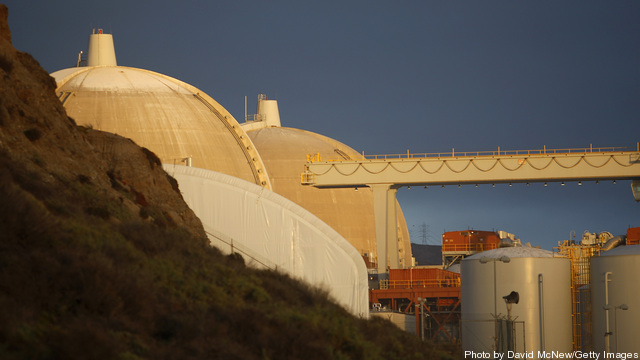 The San Onofre Nuclear Generating Station is seen from the beach along San Onofre State Beach on March 15, 2012 south of San Clemente, California.
The San Onofre Nuclear Generating Station is seen from the beach along San Onofre State Beach on March 15, 2012 south of San Clemente, California.
The head of the Nuclear Energy Institute yesterday said he was optimistic that California’s San Onofore nuclear plant would again start producing electricity and denied that the US industry was troubled by high costs and safety concerns after Fukushima.
Marvin Fertel, the president and chief executive of the Nuclear Energy Institute, said: “I’m optimistic that it will be restored to full power. If they plug in less than full power it will be for the right reasons.”
San Onofre Nuclear Generating Stations (SONGS) can supply up to 1.2m Californians with 2,200 MW of electricity and is one of only two plants in the state that contribute to 16% of baseload nuclear power, according to the Legislative Analyst’s Office.
But the plant has been offline since 31 January because of safety concerns over new steam turbines installed in 2010 and 2011 at a cost of $680 million to Southern California Edison ratepayers. The Nuclear Regulatory Commission has ordered the plant to stay offline while tubing wear issues are investigated.
Grid management agency, the California Independent Operators System, has warned that if both SONGS units remain offline this summer, San Diego and portions of the Los Angeles Basin may face power outages and has proposed measures not deployed since the California energy crisis.
Safety First
Last week, Ted Craver, chief executive officer of Edison, the parent company of operator SCE, said that the first SONGS unit would only be back online by the end of August at the earliest.
But Fertel said he was optimistic that SONGS power would be returned to the grid. “The company has handled the steam generator problem in a very transparent and professional way. This is not a culture problem there that they’re going to rush to judgment. I’m optimistic they are going to operate the plant when the time is right. They’ve just got to understand why they’re having the failures. The fact that it’s new helps. They’re just not there yet, otherwise they’d be saying it.”
Jim Boyd, a former California Energy Commissioner who also served as the state’s liaison to the NRC, said that the plant should only start operating once its safety standards were beyond question.
“SONGS is now having a significant materials problem brought on by design materials that are used in a two-year-old generator. Prior to that, the plant seemed to be pretty good, but I am aware for years we had safety culture problems in that plant. The strongest letter I ever wrote was to Edison about the safety culture.
Negotiating Safety and Business Concerns
“Maybe economics makes the decision. Nobody knows exactly what’s wrong and the cost of repairing what’s wrong may be significant. If it’s repairable will it operate at enough of a level to generate revenue to pay for the cost? We have to take a hard look at the safety issues with old plants. That steam generator was supposed to last.”
At the Commonwealth Club Climate One panel discussion in San Francisco yesterday, Fertel denied that the US nuclear industry was in trouble.
“Plants aren’t old in the way that has been described. Everything in a nuclear plant that moves is changed out – some parts are newer than what you have in your car or airplane.”
Four plants in the US would come online by 2020, but more would be in the pipeline before the close of the decade, said Fertel.
To read more Breaking Energy coverage of the nuclear industry, click here, here and here.
In response to Fukushima, the NRC has introduced new requirements for a “flex approach” to secondary power generation at nuclear plants. Mobile diesel generators will be mandatory at all 104 US reactors by the end of the year, Fertel said.
NRC this year issued construction and operating licenses for Southern Company’s Vogtle units 3 and 4 in Georgia.
California is unlikely to build any new nuclear power plants any time soon because of state law introduced in 1976 during current Governor Jerry Brown’s first tenure that requires reprocessing plants and disposal facilities before new power stations are approved.
